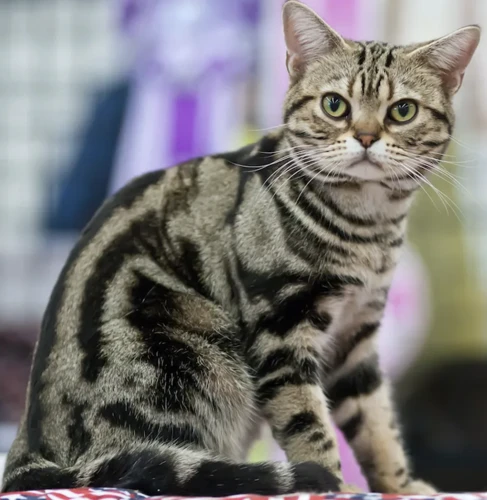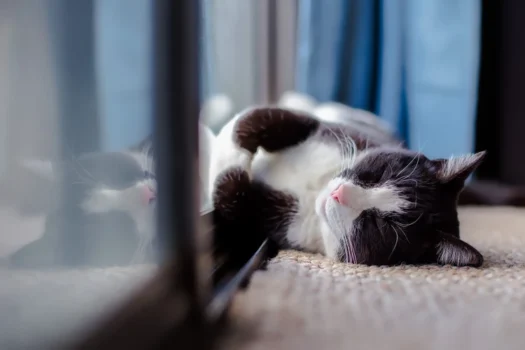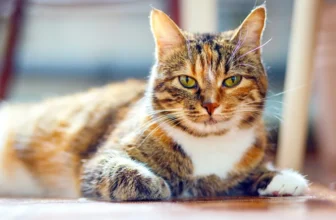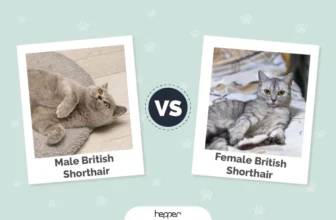Have you ever found yourself frustrated and perplexed as to why your American Shorthair cat is not using their litter box? It can be a common and frustrating issue for cat owners, but fear not! There are a variety of reasons why your feline friend may be neglecting their bathroom duties, and in this guide, we will explore the common causes and provide solutions for troubleshooting litter box problems. So, let’s dive in and uncover the reasons why your American Shorthair is not using their litter box.
Why is your American Shorthair not using the litter box?

You may have noticed that your American Shorthair is not using their litter box, leaving you perplexed and wondering what could be the issue. Many factors may contribute to this problem, such as the litter box being dirty or in an unsuitable location, your cat experiencing anxiety or stress, or even a medical issue. Pinpointing the cause of your cat’s behavior is critical to correcting this problem and ensuring their health and well-being. In the next sections, we will go over the possible reasons why your American Shorthair is not using the litter box, and provide solutions to help resolve the issue. To learn more about litter box training tips, check out our article on guidelines to train your American Shorthair to use their litter box.
Dirty litter box
Maintaining a clean litter box is crucial for the overall health and well-being of your American Shorthair. Cats are known for their cleanliness, and they will avoid using a litter box if it is dirty or has an unpleasant odor. It is essential to clean the litter box regularly. The frequency of cleaning will depend on the number of cats in the household and how often they use the litter box.
To keep the litter box clean, scoop out the waste at least once a day. If you have multiple cats, you may need to scoop more frequently. It is also recommended to replace the litter entirely once a week. Additionally, washing the litter box with soap and hot water will help keep it clean and free from bacteria.
If your cat continues to avoid using the litter box, even after cleaning it regularly, it may be time to consider other factors that could be causing the problem. You can also read our article about common litter box mistakes to avoid to ensure you’re doing everything right.
Below is a helpful table outlining the key points to remember when it comes to a dirty litter box:
| Problem | Solution |
| The litter box is dirty and smelly | Clean and scoop the litter box regularly, replace the litter entirely once a week, and wash the litter box with soap and hot water |
| The litter box is too small | Upgrade to a larger litter box that allows your cat to move comfortably |
| Too many cats in the household | Provide multiple litter boxes in various locations |
By keeping the litter box clean, providing enough space for your American Shorthair to move around comfortably, and avoiding overcrowding the litter box with too many cats, you can ensure that your cat is happy and healthy. If the issue persists, there could be other factors causing the problem, and it may be best to consult with a veterinarian or a professional cat behaviorist.
Wrong litter type
One of the reasons why your American Shorthair may not be using the litter box is because of the wrong type of litter. Just like humans have preferences for certain types of materials, cats have preferences for certain types of litter.
Clumping versus non-clumping litter: Some cats prefer clumping litter, while others prefer non-clumping litter. Clumping litter forms a solid clump when wet, making it easy to scoop out urine and feces. This litter can be more expensive, but it tends to last longer. Non-clumping litter does not clump together, and instead absorbs urine and feces. This litter is less expensive, but you need to replace it more often.
Texture: Some cats prefer litter with a finer texture, while others prefer a coarser texture. Experiment with different types of litter to see which texture your cat prefers.
Scented versus unscented litter: Some cats may not like heavily scented litter. Unscented litter may be better for cats with sensitive noses.
Color: While the color of litter may not seem important to us, some cats may be put off by certain colors. It’s best to stick with a neutral-colored litter for your cat.
When choosing litter for your American Shorthair, it’s important to keep in mind their preferences while also considering factors such as odor control, ease of cleaning, and budget. Some popular litter options for American Shorthairs include clumping clay litter, pine litter, and recycled paper litter.
Make sure to introduce new litter gradually, mixing in a small amount of the new litter with the old litter to help your cat adjust. If your cat still seems hesitant to use the litter box after changing litter types, try using a litter box attractant or consult with your vet to rule out any medical issues.
If you want to learn more about the best litter box options for American Shorthair cats, you can check out our article on this topic.
Location of the litter box
The location of the litter box significantly affects your American Shorthair’s willingness to use it. Cats are very particular about where they go to the bathroom, and the litter box should be placed in a spot that offers privacy and accessibility.
Firstly, it should be placed in a quiet and low-traffic area where your cat can have some privacy while doing its business. Cats are very sensitive to noise and commotion, so make sure the litter box is in a peaceful spot in the house where your cat can go undisturbed.
Secondly, cats don’t like to have their litter box close to their food and water. Ideally, these areas should be completely separate from each other, so consider placing the litter box in a different room. This will ensure that your American Shorthair’s litter box is not becoming a breeding ground for bacteria and that your cat’s eating area is hygienic.
Thirdly, the number of litter boxes is also crucial. According to the American Society for the Prevention of Cruelty to Animals (ASPCA), having one litter box per cat plus one extra box is the ideal rule. This gives them plenty of options and ensures that they have access to a clean litter box even if another one is occupied.
Finally, if you have multiple floors, it’s essential to have a litter box on each floor so that your cat doesn’t have to go too far when nature calls.
The location of the litter box is just as important as the cleanliness and type of litter. Be sure to provide your American Shorthair with a private and peaceful spot where it can do its business comfortably. For more information on litter box training tips, refer to our article on litter box training tips for American Shorthair kittens.
Medical issues
It is important to note that sometimes the reason why your American Shorthair is not using the litter box can be related to medical issues. In fact, this is actually one of the more common reasons, and it is important to be aware of the symptoms of these issues. Common medical issues that can cause litter box problems include urinary tract infections and kidney disease. Other symptoms to look out for include frequent urination, painful urination, blood in the urine, and excessive licking in the genital area.
If you notice any of these symptoms, it is important to take your cat to the vet for a check-up. Your vet might recommend some tests to diagnose the issue, and will most likely prescribe medication to help treat the condition. In some cases, your vet may recommend a special diet or even surgery to help improve your cat’s condition.
While medical issues can cause litter box problems, it is important to note that it is very likely they have been caused by another external factor. It is always important to rule them out so that you can focus on other methods of fixing the problem.
If your cat has been medically cleared but is still not using the litter box, there may be other reasons behind this behavior. You can read more about fixing litter box problems in our article about keeping the litter box clean with American Shorthairs or check out our article on litter box training for American Shorthair behavior for more tips and tricks.
Traumatic experience
Cats are sensitive animals and any bad experience can cause fear and anxiety that affects their behavior. If your American Shorthair had a traumatic experience associated with the litter box, it might avoid using it altogether. Traumatic experiences can be anything from being startled while using the box to a fight with another pet in the vicinity of the box.
Here are some signs that your cat might have had a traumatic experience:
- Refusal to use the litter box
- Hiding or avoiding the litter box
- Refusal to enter the room where the litter box is kept
- Excessive grooming or licking after using the litter box
- Excessive anxiety or fear when near the litter box
What can you do to help your cat overcome traumatic experiences?
- First, identify and remove the source of the traumatic experience. For example, if your cat was startled by a loud noise while using the litter box, create a quiet and calm environment around the litter box.
- Make the litter box experience as positive as possible by offering treats or catnip after successful use of the box.
- Don’t punish your cat for avoiding the litter box. This can make the problem worse.
- Consider using a different type of litter or litter box if your cat refuses to use the previous one.
- If your cat continues to avoid using the litter box, seek the advice of a veterinarian or animal behaviorist.
Remember, patience and understanding are key when trying to help your cat overcome traumatic experiences. With time and effort, your American Shorthair can learn to use the litter box again without fear or anxiety.
Anxiety or stress
Cats are sensitive creatures and can be easily stressed or anxious. If your American Shorthair is not using the litter box, it could be due to anxiety or stress. Cats can be stressed by changes in their environment, new people or pets, or even a change in their daily routine. Anxious cats may feel the need to mark their territory by urinating outside the litter box or may avoid it altogether.
Signs of anxiety or stress in cats
It’s important to watch for signs of anxiety or stress in cats so that you can address the problem promptly. Here are some signs to look out for:
| Behavioral Signs | Physical Signs |
|---|---|
| – Excessive grooming | – Loss of appetite |
| – Hiding or avoiding interaction | – Over or under sleeping |
| – Aggressive behavior | – Diarrhea or constipation |
| – Urinating or defecating outside the litter box | – Excessive shedding |
If you notice any of these signs in your American Shorthair, it’s important to identify the cause of their anxiety and address it promptly.
Reducing anxiety and stress in cats
There are several ways to help reduce anxiety and stress in cats, and help them feel more comfortable using their litter box again. Here are some tips:
- Provide a safe space: Make sure your cat has a designated safe space where they can retreat to when feeling stressed or anxious. This could be a cozy bed, a perch by a window, or a secluded corner where they feel secure.
- Eliminate stressors: If you can identify what is causing your cat’s anxiety, try to eliminate the stressor. This could mean limiting visitors to the home, providing separate feeding areas for multiple cats, or keeping loud noises to a minimum.
- Use pheromones: There are synthetic pheromones available that can help reduce anxiety in cats. These are available in sprays, diffusers, and collars. They work by mimicking the scent of the cat’s natural pheromones, which can help them feel more calm and comfortable.
- Play with your cat: Regular playtime can help reduce anxiety in cats. Use interactive toys that mimic their natural prey drive, such as feather wands or laser pointers.
- Crate training: Crate training can help your cat feel more comfortable and secure during times of stress or anxiety, such as during car rides or vet visits.
By addressing the cause of your American Shorthair’s anxiety and stress, and providing a safe and comfortable environment for them, you can help them feel more comfortable and confident using their litter box again.
Troubleshooting guide for litter box problems in American Shorthairs
Are you tired of dealing with litter box problems with your American Shorthair? Don’t worry, we’ve got you covered. In this section, we will share a comprehensive troubleshooting guide to help you identify the root cause of your furry friend’s litter box issues and provide you with practical solutions. By following our step-by-step approach, you’ll be able to create a stress-free environment for your American Shorthair, and both of you will enjoy a harmonious relationship. Let’s get started!
Clean the litter box regularly
A dirty litter box may be the reason why your American Shorthair is not using it. It is crucial to clean the litter box regularly. Using gloves and a scooper, remove the clumped litter and feces daily. Wash the litter box with soap and warm water at least once a week, and let it dry completely before putting fresh litter in it.
To prevent the litter box from retaining unpleasant odors, consider sprinkling baking soda at the bottom of the box before adding the litter. Ensure the litter box is deep enough to minimize spillovers. You could also use litter liners to make cleaning easier and to prevent any waste from clinging to the litter box.
Not cleaning the litter box regularly can result in your cat avoiding it, and finding other locations to relieve itself. Make sure you adhere to a cleaning routine and maintain a clean litter box. A clean and hygienic litter box is essential for your cat’s health and for ensuring they continue to use it as intended. Your furry friend deserves to have a comfortable and clean space to do their business.
Choose the right litter type
Choosing the right litter type can be a crucial factor in solving litter box problems for your beloved American Shorthair. Here are some things to consider when making your choice:
- Texture: Cats have unique preferences when it comes to texture, so it’s important to take this into account when choosing a litter type. Some cats like a fine-grain texture, while others may prefer a more coarse texture. It’s recommended to choose a litter that mimics the feel of sand or dirt, as this is what cats are instinctively drawn to.
- Clumping vs non-clumping: Another important factor to consider is whether to choose clumping or non-clumping litter. Clumping litter is easier to clean and remove waste, but it can also be more expensive. Non-clumping litter is less expensive, but may require daily complete box cleanings to avoid lingering smells.
- Scent: While scented litter may sound like a good idea, it’s important to keep in mind that cats have a strong sense of smell, and may not appreciate the artificially added fragrance. Unscented litter may be a better option, but it’s important to note that the litter box will still need to be cleaned often and well.
- Material: Litter types come in various materials, such as clay, corn, or crystal. Clay is a popular option, but some cats may dislike the dust that it generates. Corn and crystal litters may be a good alternative as they are dust-free and more environmentally friendly, but they may be less absorbent.
- Transitioning: When introducing a new litter type, it’s best to mix it into the current litter gradually. This way, your American Shorthair can get used to the new texture and scent without completely forsaking the old litter. Doing it slowly will help avoid startling your cat, resulting in her not using the litter box.
By taking these factors into account and trying out different litter types, you can find the perfect litter for your American Shorthair and, in turn, solve any litter box problems she may be exhibiting.
Find the right location for the litter box
Cats are territorial animals and prefer to have their litter box in a quiet and private location. Finding the right location for the litter box can play a crucial role in solving litter box problems with your American Shorthair.
Factors to consider when finding the right location
| Consideration | Description |
|---|---|
| Accessibility | The litter box should be easily accessible and not located in a high traffic area. Your cat needs to feel comfortable and safe while using the litter box. |
| Number of cats | If you have multiple cats, it’s important to have more than one litter box. Place the litter boxes in different locations to prevent fights over the use of litter boxes. |
| Avoid noisy areas | Cats are easily startled by loud noise. Choose a quiet and peaceful location for the litter box to prevent scaring your cat while they use the litter box. |
| Privacy | Cats need their privacy while using the litter box. Choose a location that is away from high traffic areas and has a minimal chance of distractions. |
| Space | Cats like to have enough space to move around while using the litter box. A small and confined space may cause discomfort and lead to litter box issues. |
| Temperature | Cats prefer a warm environment while using the litter box. Avoid placing the litter box in a cold location or direct sunlight to prevent discomfort. |
Tips for a proper location
– Place the litter box in a secluded, quiet location of the house
– If your American Shorthair is afraid of another pet in the home, place the litter box higher up to prevent other pets from getting too close
– Avoid placing the litter box near noisy appliances like television sets or washing machines
– Provide an easy and accessible path to the litter box so that your cat can quickly and easily access it
– Place the litter box in an area with ample space for your American Shorthair to move around.
Finding the right location for the litter box can take some time and experimentation, but it’s definitely worth the effort. By providing your cat with a comfortable, relaxed environment, you can help eliminate litter box problems and improve their overall well-being.
Visit the vet to rule out medical issues
If your American Shorthair is regularly avoiding the litter box, it might indicate that there is an underlying medical issue. To rule out any potential medical problems, it’s important to take your cat to the vet for a thorough examination.
Some medical issues that can lead to litter box problems in American Shorthairs include urinary tract infections, bladder stones, kidney problems, and diabetes. These health issues can cause painful urination, making your cat reluctant to use the litter box.
Here are some symptoms to watch out for:
| Symptom | Description |
|---|---|
| Straining to urinate | Your cat may seem to be in discomfort or in pain while urinating, and may spend an extended amount of time in the litter box trying to go. |
| Frequent urination | If your cat is using the litter box more frequently than usual, it could be a sign of a urinary tract issue. |
| Blood in urine | If you notice any redness or discoloration in your cat’s urine, it could contain blood, which is a potential sign of a serious medical issue. |
| Litter box avoidance | If you notice your cat avoiding the litter box entirely, it’s important to take your cat to the vet as soon as possible. |
If your vet identifies a medical issue, they will recommend an appropriate treatment plan for your cat. It is important to follow the vet’s advice to help your cat recover as quickly and easily as possible.
Remember, litter box problems can be frustrating for cat owners, but they are often a sign of an underlying problem. By taking your cat to the vet and addressing the issue, you can help your American Shorthair successfully use the litter box again, and avoid any further accidents in the house.
Help your cat overcome traumatic experiences
Traumatic experiences can have a profound effect on your American Shorthair’s toileting habits. In some cases, a common source of traumatic experiences can be something as simple as being startled while using the litter box, or having the litter box in an area with a lot of loud and sudden noises. However, there are some more serious traumatic experiences that can affect your cat.
Common traumatic experiences:
| Traumatic Experience | Description |
|---|---|
| Aggressive behavior from other cats in the household | Experiencing aggressive behavior from other cats can cause your American Shorthair to avoid the litter box out of fear of being attacked. |
| Recent move or major changes in the household | A recent move or major changes in the household can cause your cat to feel stressed and anxious, making them more likely to avoid the litter box. |
| Previous history of being punished for toileting accidents | If your cat has been punished for toileting accidents in the past, they may begin to associate the litter box with punishment and avoid using it altogether. |
If your American Shorthair is avoiding the litter box due to a traumatic experience, it is important to address the underlying issue. This may involve working with a professional animal behaviorist or simply providing a safe and comfortable environment for your cat to thrive in.
Steps to help your cat overcome traumatic experiences:
- Provide a calm and quiet litter box area
- Use pheromone products to reduce stress
- Gradually introduce your cat to new experiences and situations
- Provide positive reinforcement and rewards for using the litter box
- Work with a professional animal behaviorist to address underlying behavior issues
By taking the appropriate steps to help your American Shorthair overcome traumatic experiences, you can encourage them to feel more comfortable and relaxed in their litter box environment. With patience and persistence, your cat can get back to using the litter box regularly and consistently.
Reduce anxiety and stress
Reducing anxiety and stress in American Shorthairs is crucial to solving litter box problems. Cats are sensitive to changes in their environment, and even small changes can cause stress and anxiety. Here are some tips to help your American Shorthair feel more relaxed:
| Tip | Explanation |
|---|---|
| Playtime | Engage your American Shorthair in playtime regularly to help reduce anxiety and stress. Provide toys that they can interact with independently and ones that require more human interaction. It’s important to establish a routine for playtime to help alleviate boredom and anxiety. |
| Safe space | Create a safe space for your American Shorthair where they can retreat to when they feel overwhelmed or anxious. This can be a separate room or area of the house with their bed, toys, and food and water bowls. Make sure the safe space is quiet and away from high-traffic areas of the home. |
| Feliway diffuser | Use a Feliway diffuser to release calming pheromones that can help reduce anxiety and stress in your American Shorthair. The diffuser mimics the pheromones that cats naturally release when they feel happy and secure, helping your cat to feel more relaxed and comfortable in their environment. |
| Reduce noise | Avoid loud noises and sudden movements around your American Shorthair as it can trigger anxiety and stress. Reduce noise levels by turning down the TV or radio, using sound-absorbing materials like carpets or curtains, and avoiding vacuuming or any other noisy activities around your cat. |
| Consistent routine | Establish a consistent routine for your American Shorthair to help reduce anxiety and stress. Feeding, playtime, and litter box cleaning should be done at the same time every day, so your cat knows what to expect and feels more secure in their environment. |
Reducing anxiety and stress in American Shorthairs involves creating a calming environment, establishing a routine, and providing outlets for physical and mental stimulation. By following these tips, you will not only help your cat feel more comfortable but also address any potential litter box problems they may have been experiencing.
Prevention and Conclusion
As much as possible, preventing litter box problems is easier than troubleshooting them. By taking some simple but effective measures, you can keep your American Shorthair happy and healthy. In this section, we’ll go over some key tips for preventing litter box issues in the future. Additionally, we’ll summarize the steps you should take to help your American Shorthair start using the litter box again. Let’s explore these vital points below.
Prevent litter box problems in American Shorthairs
Preventing litter box problems is easier than dealing with them once they arise. Here are some tips to keep your American Shorthair cat using the litter box regularly.
| Tip | Description |
|---|---|
| Keep the litter box clean | Make sure you clean the litter box daily and replace the litter entirely once a week. This will keep your cat happy and prevent them from avoiding a dirty litter box. |
| Provide enough litter boxes | Having enough litter boxes is important when you have multiple cats. The rule of thumb is one litter box per cat plus one extra. |
| Choose an appropriate location | Place the litter box in a quiet, private location away from your cat’s food and water bowls. This will give your cat the privacy they need to use the litter box without being interrupted or bothered. |
| Use the right litter | Use a litter that your cat likes. Cats have different preferences when it comes to litter texture and scent, so experiment with different types until you find the one your cat prefers. |
| Encourage positive experiences | Encourage your cat to use the litter box by rewarding them every time they use it. You can give them treats or praise to create a positive association with the litter box. |
By following these tips, you can prevent litter box problems in your American Shorthair and ensure that they have a happy and healthy bathroom routine. Remember, a clean and comfortable litter box is key to a happy feline household.
Conclusion
After reading through this troubleshooting guide for litter box problems in American Shorthairs, you should have a better understanding of why your beloved feline may not be using the litter box as they should be. Remember that litter box issues are common, but they can be resolved with the correct approach.
By keeping the litter box clean and choosing the proper litter type and location, you can prevent many of the problems that cats have with using the litter box. Additionally, it is crucial to visit the vet to rule out any underlying medical issues. Traumatic experiences and anxiety can also deter cats from using the litter box, so providing a stress-free environment can go a long way towards resolving these issues.
Prevention is key when it comes to litter box problems, so make sure to prioritize the cleanliness and accessibility of the litter box for your American Shorthair.
While troubleshooting litter box problems can be frustrating, with patience and consistency, you can help your cat get back to using the litter box as intended. If you are still experiencing issues even after following the troubleshooting tips in this guide, don’t hesitate to consult with your veterinarian or a cat behaviorist for additional assistance.
Always prioritize your American Shorthair’s litter box needs and make sure to address any issues promptly to keep your furry friend happy and healthy.
Frequently Asked Questions
1. How often should I clean my American Shorthair’s litter box?
It’s recommended to clean the litter box at least once a day, and more often if you have multiple cats or your cat is a heavy user.
2. What type of litter should I use?
There are many types of litter available, but it’s important to choose one that your cat is comfortable with. Some popular options include clay litter, silica gel litter, and natural litters made from materials like wood chips or corn cob.
3. Can a dirty litter box cause health problems for my American Shorthair?
Yes, a dirty litter box can lead to health problems such as urinary tract infections or other infections. It can also cause stress and anxiety for your cat.
4. What should I do if my American Shorthair is avoiding the litter box?
It’s important to first rule out any medical issues by taking your cat to the vet. If there are no physical problems, consider the litter box hygiene, type of litter, and location. You may also want to check if your cat is experiencing stress or anxiety.
5. What is the best location for a litter box?
The best location for a litter box is in a quiet, low-traffic area of your home where your cat can access it easily. Avoid placing it near your cat’s food and water dishes.
6. Can I train my American Shorthair to use the litter box?
Most cats are naturally inclined to use the litter box, but some may need training. To do this, confine your cat to a small area with the litter box and gradually increase the space as your cat becomes comfortable using it.
7. How can I reduce my cat’s stress and anxiety?
You can reduce stress and anxiety in your cat by providing a calm and stable home environment, giving your cat plenty of attention and playtime, and utilizing tools like pheromone diffusers and calming sprays.
8. What should I do if my American Shorthair still refuses to use the litter box?
If your cat continues to refuse the litter box despite troubleshooting, consult with your vet or a feline behavior specialist for further guidance.
9. Can my American Shorthair use a covered litter box?
While some cats may prefer a covered litter box for privacy, others may not like the enclosed space. It’s important to monitor your cat’s behavior and body language to determine if a covered box is suitable for them.
10. How can I prevent litter box problems in the future?
You can prevent litter box problems by following good hygiene practices, monitoring your cat’s behavior and addressing issues promptly, providing a comfortable and accessible litter box, and creating a calm and stress-free home environment.







